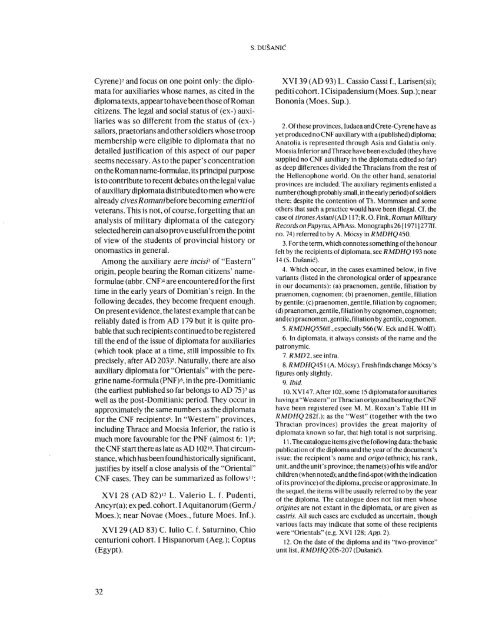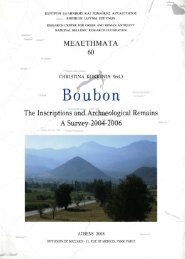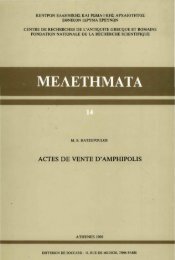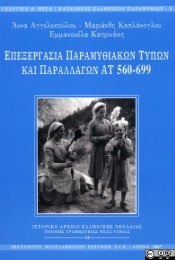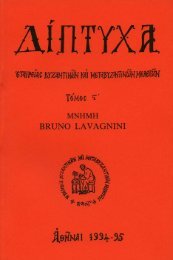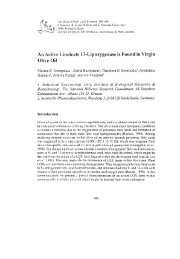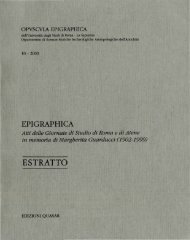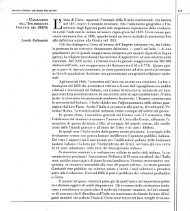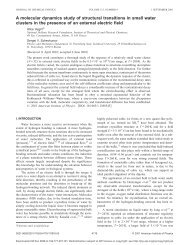roman name-formula
roman name-formula
roman name-formula
- No tags were found...
You also want an ePaper? Increase the reach of your titles
YUMPU automatically turns print PDFs into web optimized ePapers that Google loves.
Cyrene) 2 and focus on one point only: the diplomata<br />
for auxiliaries whose <strong>name</strong>s, as cited in the<br />
diploma texts, appearto have been those of Roman<br />
citizens. The legal and social status of (ex-) auxiliaries<br />
was so different from the status of (ex-)<br />
sailors, praetorians and other soldiers whose troop<br />
membership were eligible to diplomata that no<br />
detailed justification of this aspect of our paper<br />
seems necessary. As to the paper's concentration<br />
on the Roman <strong>name</strong>-<strong>formula</strong>e, its principal purpose<br />
is to contribute to recent debates on the legal value<br />
of auxiliary diplomata distributed to men who were<br />
already cives Romanibef ore becoming emeriti of<br />
veterans. This is not, of course, forgetting that an<br />
analysis of military diplomata of the category<br />
selected herein can also prove useful from the point<br />
of view of the students of provincial history or<br />
onomastics in general.<br />
Among the auxiliary aere incisP of "Eastern"<br />
origin, people bearing the Roman citizens' <strong>name</strong><strong>formula</strong>e<br />
(abbr. CNFH are encountered for the first<br />
time in the early years of Domitian's reign. In the<br />
following decades, they become frequent enough.<br />
On present evidence, the latest example that can be<br />
reliably dated is from AD 179 but it is quite probable<br />
that such recipients continued to be registered<br />
till the end of the issue of diplomata for auxiliaries<br />
(which took place at a time, still impossible to fix<br />
precisely, after AD 203) 5 . Naturally, there are also<br />
auxiliary diplomata for "Orientals" with the peregrine<br />
<strong>name</strong>-<strong>formula</strong> (PNF) 6 , in the pre-Domitianic<br />
(the earliest published so far belongs to AD 75) 7 as<br />
well as the post-Domitianic period. They occur in<br />
approximately the same numbers as the diplomata<br />
for the CNF recipients 8 . In "Western" provinces,<br />
including Thrace and Moesia Inferior, the ratio is<br />
much more favourable for the PNF (almost 6: l) 9 ;<br />
the CNF start there as late as AD 102 l0 . That circumstance,<br />
which has been foundhistorically significant,<br />
justifies by itself a close analysis of the "Oriental"<br />
CNF cases. They can be summarized as follows 11 :<br />
XVI 28 (AD 82)»2 L. Valerio L. f. Pudenti,<br />
Ancyr(a); ex ped. cohort. I Aquitanorum (Germ./<br />
Moes.); near Novae (Moes., future Moes. Inf.).<br />
XVI29 (AD 83) C. Iulio C. f. Saturnino, Chio<br />
centurioni cohort. I Hispanorum (Aeg.); Coptus<br />
(Egypt).<br />
32<br />
S. DUSANIC<br />
XVI 39 (AD 93) L. Cassio Cassi f., Larisen(si);<br />
pediti cohort. I Cisipadensium (Moes. Sup.); near<br />
Bononia (Moes. Sup.).<br />
2. Of these provinces, Iudaea and Crete-Cyrene have as<br />
yet produced no CNF auxiliary with a (published) diploma;<br />
Anatolia is represented through Asia and Galatia only.<br />
Moesia Inferior andThrace have been excluded (they have<br />
supplied no CNF auxiliary in the diplomata edited so far)<br />
as deep differences divided the Thracians from the rest of<br />
the Hellenophone world. On the other hand, senatorial<br />
provinces are included. The auxiliary regiments enlisted a<br />
number (though probably small, in the early period) of soldiers<br />
there; despite the contention of Th. Mommsen and some<br />
others that such a practice would have been illegal. Cf. the<br />
case of tirones Asiani (AD 117; R. O. Fink, Roman Military<br />
Records on Papyrus, APhAss. Monographs 26 [ 1971 ] 277ff.<br />
no. 74) referred to by A. Mócsy in RMDHQ450.<br />
3. For the term, which connotes something of the honour<br />
felt by the recipients of diplomata, see RMDHQ193 note<br />
14 (S. Dusanic).<br />
4. Which occur, in the cases examined below, in five<br />
variants (listed in the chronological order of appearance<br />
in our documents): (a) praenomen, gentile, filiation by<br />
praenomen, cognomen; (b) praenomen, gentile, filiation<br />
by gentile; (c) praenomen, gentile, filiation by cognomen;<br />
(d) praenomen, gentile, filiation by cognomen, cognomen;<br />
and (e) praenomen, gentile, filiation by gentile, cognomen.<br />
5. RMDHQ556ff., especially 566 (W. Eck and H. Wolff).<br />
6. In diplomata, it always consists of the <strong>name</strong> and the<br />
patronymic.<br />
7. RMD2, see infra.<br />
8. RMDHQA51 (A. Mócsy). Fresh finds change Mócsy's<br />
figures only slightly.<br />
9. Ibid.<br />
10. XVI47. After 102, some 15 diplomata for auxiliaries<br />
having a "Western" or Thracian origo and bearing the CNF<br />
have been registered (see M. M. Roxan's Table III in<br />
RMDHQ 282f.); as the "West" (together with the two<br />
Thracian provinces) provides the great majority of<br />
diplomata known so far, that high total is not surprising.<br />
11. The catalogue items give the following data: the basic<br />
publication of the diplomaandthe year of the document's<br />
issue; the recipient's <strong>name</strong> and origo (ethnic); his rank,<br />
unit, and the unit's province; the <strong>name</strong>(s) of his wife and/or<br />
children (when noted); andthe find-spot (with the indication<br />
of its province) of the diploma, precise or approximate. In<br />
the sequel, the items will be usually referred to by the year<br />
of the diploma. The catalogue does not list men whose<br />
origines are not extant in the diplomata, or are given as<br />
castris. All such cases are excluded as uncertain, though<br />
various facts may indicate that some of these recipients<br />
were "Orientals" (e.g. XVI128; App. 2).<br />
12. On the date of the diploma and its "two-province"<br />
unit list, RMDHQ205-201 (Dusanic).


